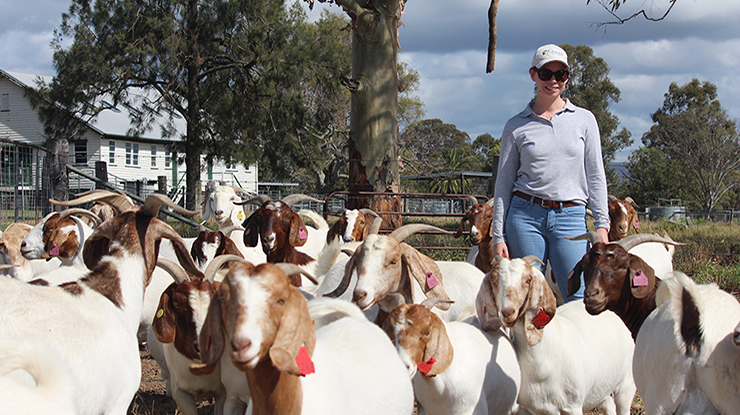 Dr Sarah Meale, project researcher and Senior Lecturer in Animal Science and Production at the University of Queensland. Image: Sarah Meale.
Dr Sarah Meale, project researcher and Senior Lecturer in Animal Science and Production at the University of Queensland. Image: Sarah Meale.
Industry game-changer: Goat Sustainability Project underway
Key points
- A new three-year MLA Donor Company Goat Sustainability Project, will quantify the greenhouse gas emissions of goats and assess the carbon balance and potential for sequestration on demonstration sites.
- It will investigate the impact of various factors including reproductive rate, kid growth rate, parasite burden, and heat stress on emissions.
- Researchers hope the project will help pave the way for a more environmentally friendly and economically viable future for the goat industry.
A new project is underway to not only quantify the greenhouse gas emissions of goats but also assess the carbon balance and potential for sequestration for producers on demonstration sites.
When addressing growing concerns about agriculture’s contribution to climate change and greenhouse gas (GHG) emissions, the focus has primarily been placed on the beef, dairy and sheepmeat sectors.
There is, however, a significant gap in data and research when it comes to the goat industry, particularly for extensive and rangeland goat enterprises.
With the majority of goats raised in these types of systems in Australia, understanding and addressing their emissions and sustainability is critical.
To bridge this knowledge gap and help drive practical outcomes for goat producers, a three-year Goat Sustainability Project has been launched, funded through the MLA Donor Company (MDC) in partnership with the University of Queensland (UQ).
Project researcher and Senior Lecturer in Animal Science and Production at UQ, Dr Sarah Meale, said the project aims to not only quantify the GHG emissions of goats but also assess the carbon balance and potential for sequestration on demonstration sites.
“We hope that our findings will help to provide a comprehensive understanding of goat emissions and sustainable management practices and showcase evidence-based opportunities for producers to adopt more sustainable management practices on-farm,” Dr Meale said.
Project objectives and outcomes
The Goat Sustainability Project has three primary objectives:
- Quantifying GHG emissions of goats: The project will comprehensively study emissions both in field and in laboratory settings. This includes different production systems, dietary compositions, growth stages, and physiological statuses. It is an ambitious effort to understand the emissions profile in depth.
- Carbon balance and potential: The project will evaluate the carbon balance in various ecosystems, such as Mitchell grass downs, shaded downs, and Mulga-dominant forests, to assess their carbon sequestration potential. This assessment will be based on environmental factors and changes in stock management practices.
- Testing and management practices: The project will investigate the impact of various factors, such as reproductive rate, kid growth rate, parasite burden, and heat stress on emissions. Sustainable landscape outcomes will be demonstrated through practices such as low-intensity rotational grazing and monitoring feedbase composition.
Through this, the project aims to achieve:
- Improved carbon literacy: This project will engage producers and advisors in the goat industry, enhancing their knowledge of carbon emissions and sustainability practices. This newfound understanding will benefit the industry as a whole.
- Demonstrating sustainable goat management: The project will showcase how goats can be sustainably managed within different landscapes. This demonstration is essential for both the industry and the environment.
Activity timeline
Project research is currently underway, collecting data from various goat producers in Queensland across four different pasture types and 20 different browse samples, to gain a comprehensive understanding of goat diets.
The second year of the project will then focus on selecting three feeds that yield the best outcomes and testing them in animals. This will involve metabolism trials and measuring actual methane emissions and digestion in animals.
The second year will also include a trial investigating the effects of pregnancy and parasite loads on goat emissions.
“We're going to test the effect of physiological status, including pregnancy and parasites on methane emissions as well,” Dr Meale said.
“In the final year, methane emissions from goats under heat stress will be quantified, alongside on-farm measurements of methane emissions throughout the three years.
“At the conclusion of this project, in collaboration with industry, we hope to be able provide evidence-based advice on best sustainable grazing practices and materials that can be used to support ongoing participation of the goat sector in industry sustainability initiatives, and for producers to enhance their on-farm sustainability outcomes,” Dr Meale said.
With a focus on quantifying GHG emissions, assessing carbon balance, and demonstrating sustainable management practices, Dr Meale said the project has the potential to be a game-changer for goat producers.
“By enhancing carbon literacy and promoting sustainable practices, knowledge and insights gained over the next three years could help pave the way for a more environmentally friendly and economically viable future for the goat industry,” Dr Meale said.



